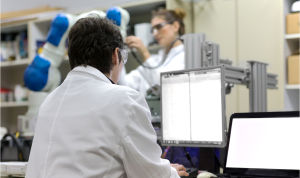Client success story
Lab Workflow Automation
Business Value: Reliable Lab Automation
Summary: Implementation Of Simplified Lab Automation Architecture
A mid-size biotechnology company had a variety of lab assays to support discovery and pre-clinical work, but had a disparate and ad-hoc architecture built up over time to manage the data. bPrescient developed automated workflows and best practices to make an integrated environment that supported continued growth.
Challenge: Disparate Lab Systems Leading To Inefficiencies
The client had a variety of lab data systems and touchpoints with CROs and other service providers, but no overarching architecture and processes to guide development. Continuing to develop data management tools for new assays in an ad-hoc manner was leading to inefficiencies and problems assembling cross-assay data sets for analysis.
Solution: Standard Processes And Simplified Architecture
bPrescient’s team reviewed the existing infrastructure, identified services that could be consolidated and retired, produced a census of company data, and development of a plan for bringing in new technologies and defining new standard operating procedures to lab data management and analysis. The tools spanned both 3rd party applications and in-house tools, and the effort included implementing more consistent registration protocols and improved metadata to support data integration.
Outcome: Ability To Respond Quickly To New Assays And Requirements
The client attained a simplified architecture with less reliance on one-off scripts and third-party automation services. The new system minimized integration points between data collection, analysis, and registration. The client’s proprietary code is now version controlled and deploys automatically to their cloud environment using an industry standard Infrastructure-as-Code solution. This streamlined workflow enabled rapid prototyping of new software in a consistent and secure environment.
The client can now quickly respond to changing lab procedures and analytical requirements. This accelerates their ability to add new assays and assemble cross-assay data sets to support discovery and pre-clinical workflows.

